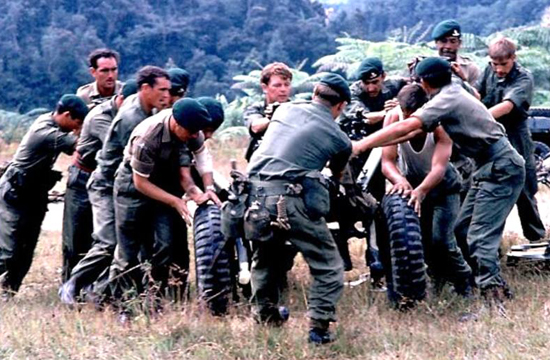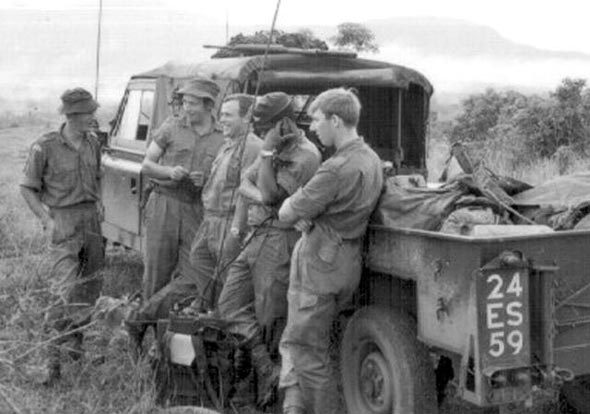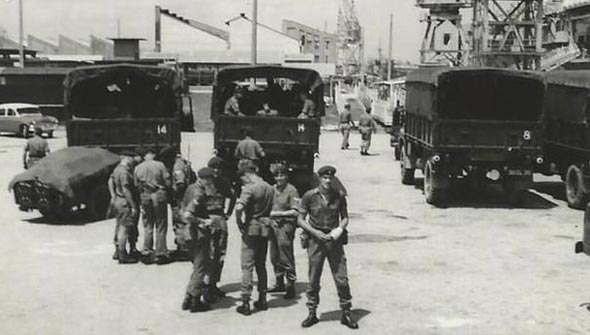'29 Commando Regiment RA'
The first Army Commandos were raised by a Gunner, Lt Col John Durnford-Slater RA in June 1940, following the defeat ending with the evacuation at Dunkirk, The Commandos struck at the German forces at a time when Britain was otherwise powerless. Raids were made on the coasts of Norway, France and the Mediterranean. By the time of the Normandy landings of 6 June 1944, the Commando forces were of a considerable size and had played a vital part on operations in all theatres of war.
After the Second World War the Commando role passed entirely to the Royal Marines, the Royal Navy’s amphibious infantry. Army Commando units ceased to exist. In the late 1950s, Britain’s defence policy began to stress the importance of a worldwide maritime strategy. The Royal Navy commissioned Commando Carriers such as HMS Bulwark and HMS Albion. The Royal Marines, who no longer had their own artillery decide that they required support from an Army artillery Regiment.
During 1962, 29 Field Regiment RA were deployed with 25 Pounder guns in Aden and Kuwait, deterring Iraq from invading the oil fields. On the back of these deployments, the Regiment was chosen to re-role as Commando Artillery. The men of the newly formed 29 Commando Regiment RA trained for and passed the All Arms Commando Course at Commando Training Centre Royal Marines Lympstone. It was a proud and historic moment when the first Army Commandos since the end of the War received their Green Berets on 15 May 1962. The 25 Pounders in service with the Regiment at that time were then replaced by the 105mm Pack Howitzer. In 1965, 95 Commando (Light) Regiment, Royal Artillery, was formed. In 1971 95 Commando joined with 29 Commando.
Since this time, 29 Commando Regiment Royal Artillery has deployed around the globe as part of 3 Commando Brigade. Over the last 43 years the Regiment has operated in every major conflict the Brigade has been involved in. This has included Brunei (1962), Borneo (1963-66), Aden (1966-67), Cyprus (1974), The Falklands (1982) and numerous tours of Northern Ireland. More recently the Regiment has deployed to Iraq (1991 and 2003), Kosovo (1994), Bosnia (1996), Sierra Leone (2000), and Afghanistan (2001, 2006, 2008 and 2011).
The composition of the Regiment since it’s formation in 1962 has changed constantly to accommodate the demands made on the UK Armed Forces.
To become a Commando Gunner you must pass the arduous All Arms Commando Course held at Royal Marines Training Centre, Lympstone, which in turn earns you the right to proudly wear the coveted Green Beret.
[Source MOD]
Gallery Images of 95 Commando and 29 Commando
95 Commando (Light) Regt. RA
7 (Sphinx) Battery
Commando trained currently based at RM Condor, Arbroath.
8 (Alma) Battery
Commando trained. Currently based in the Royal Citadel Plymouth the Battery is known as "Black Eight" because of their efforts at the Battle of Alma where the Battery fired more rounds than any other leaving the faces of the gunners black with powder stains. Black Eight is the second gun battery in 29 Cdo. Regiment and is also equipped with six 105mm Light Guns and three Observation Parties.
145 (Maiwand) Commando Battery
29 Field Regt RA became 29 Commando Lt Regt, RA in 1962. This consisted of 3 gun batteries - 8 (Alma), 79 (Kirkee) & 145 (Maiwand). Each battery consisted of 4 x 105mm Pack Howitzers (Italian Mountain Gun) and manned by approx. 65 men.
23 (Gibralter 1779 -1783) Battery
Commando trained HQ Battery based at the Royal Citadel, Plymouth including RLC attached ranks.
79 (Kirkee) Battery
The Battery converted to the Commando role on 15th May 1962. Two years later saw the Regiment based in Singapore and serving in Borneo and Malaya where it saw action in the jungle role. The early seventies saw the battery based in Malta until it returned to The Royal Citadel in 1974. The troubles in Northern Ireland saw the Battery deployed on four Operation BANNER tours. The Battery has also served as part of the UN peacekeeping force in Cyprus on two occasions, the last in 1995.
In 1982 the Battery deployed with the Regiment on Operation Corporate, the operation to recover the Falkland Islands. Landing in San Carlos on 21 May 1982 the Battery was the first fire unit ashore and the first to fire in anger. Over the course of the war the Battery fired 2,200 rounds and the tactical group supported 42 Commando on foot throughout. Initially moving to Teal Inlet on 31 May the battery moved to Estancia House alongside 3 PARA and finally to Two Sisters within range of Port Stanley. The campaign was the ultimate test for Regiment in extremely hostile conditions which tested gunnery, men and logistics to their very limits and then further still.
The Battery took part in Operation Haven in1991 to provide a safe and secure haven for the Kurds against Saddem Hussein in Northern Iraq and three years later in 1994 it reinforeced 7 Battery with two Fire support Teams and two gun detachments for Operation Driver to block predicted Iraqi incursion into Kuwait which had echoes of the deployment to Kuwait of 1961.
Kirkee served in the Balkans in 1995 as part of Operation Lodestar (Bosnia-Herzgovina). In 2003 the Battery was split up to reinforce 7 and 8 Batteries for Operation Telic 1, the liberation of Iraq. In 2005 the Battery deployed to Helmand Province Afghanistan on Operation Herrick V returning two years later on Operation Herrick IX. The Battery’s latest operational deployment was to Afghanistan in 2011 on Operation Herrick XIV. The Battery also contributed, at short notice, to the security for the hugely successful 2012 Olympic Games in London.
Source: The Royal Artillery Association .
148 ( Meiktila ) Battery
History
(source Stu Hart (ex 29 Cdo) : The Combined Operations Bombardment Units (COBUs) provided fire direction for ships in shore bombardment in World War 2. The first COBU was formed in 1940 and by the end of the war there were five in existence. In 1946 all were disbanded, except No.2 COBU which joined the School of Combined Operations (later the Amphibious Warfare Centre) at Fremington. 3 Independent Combined Operations Bombardment Troop (3 ICOBT) was raised to serve with the 40th Infantry Division in Hong Kong in 1949 and soon more Amphibious Observation Units, as they were now called, were in existence. These were combined to form 95th Amphibious Observation Regiment, with its headquarters at Fremington in Devon but batteries stationed at fleet bases throughout the world. 166 Battery, based at Malta, participated in the Suez invasion in November 1956(Operation Musketeer).
148 Battery has been in existence under various names since 1842. After 1945 it became a training unit but converted to the Amphibious Observation role in 1960. At around the same time it was decided that the Royal Marines, who no longer included gunners in their ranks, needed specialist fire support from an Army artillery regiment. Up until then 3 Commando Brigade had relied on whatever gunner regiment was available. 29th Field Regiment was serving in Kuwait in 1962 when it was chosen to take up this role. Its members were to be the first Army Commandos since 1946 and the first men to complete training received their green berets on 15 May 1962. Later 95 Regiment was also re-roled as a Commando Light Regiment with the 105mm pack howitzer. 148 Battery was to continue in the amphibious observation role for 95 as a Commando Forward Observation Battery, while 20 Battery did the same job for 29. Later a Territorial Army unit, 881 Battery, was formed.
Members of 148 Battery saw service in the Malay Peninsula 1963-66, Borneo 1963-66, the Radfan in 1964 and in Aden at various times between 1960 and 1967. In 1971 the battery returned to the UK from Singapore, along with the rest of 3 Commando Brigade, and took up its present location at Poole. With the general reduction of the Royal Navy and gun-armed ships in particular there seemed to be less need for such units. The various batteries had at certain times changed regiments so when 95 Commando Regiment was disbanded in 1975, 148 Battery survived as part of 29 Regiment. 20 and 881 Batteries were not so lucky and 148 became the sole remaining NGFO unit. It too was scheduled for disbandment when Argentina invaded the Falkland Islands in April 1982.
289 Commando Light Battery (V)
A volunteer military reservist unit of Greater London. Redesignated in 1977 as 289 Commando Light Battery (V) from 289 Parachute Battery RHA (V).


